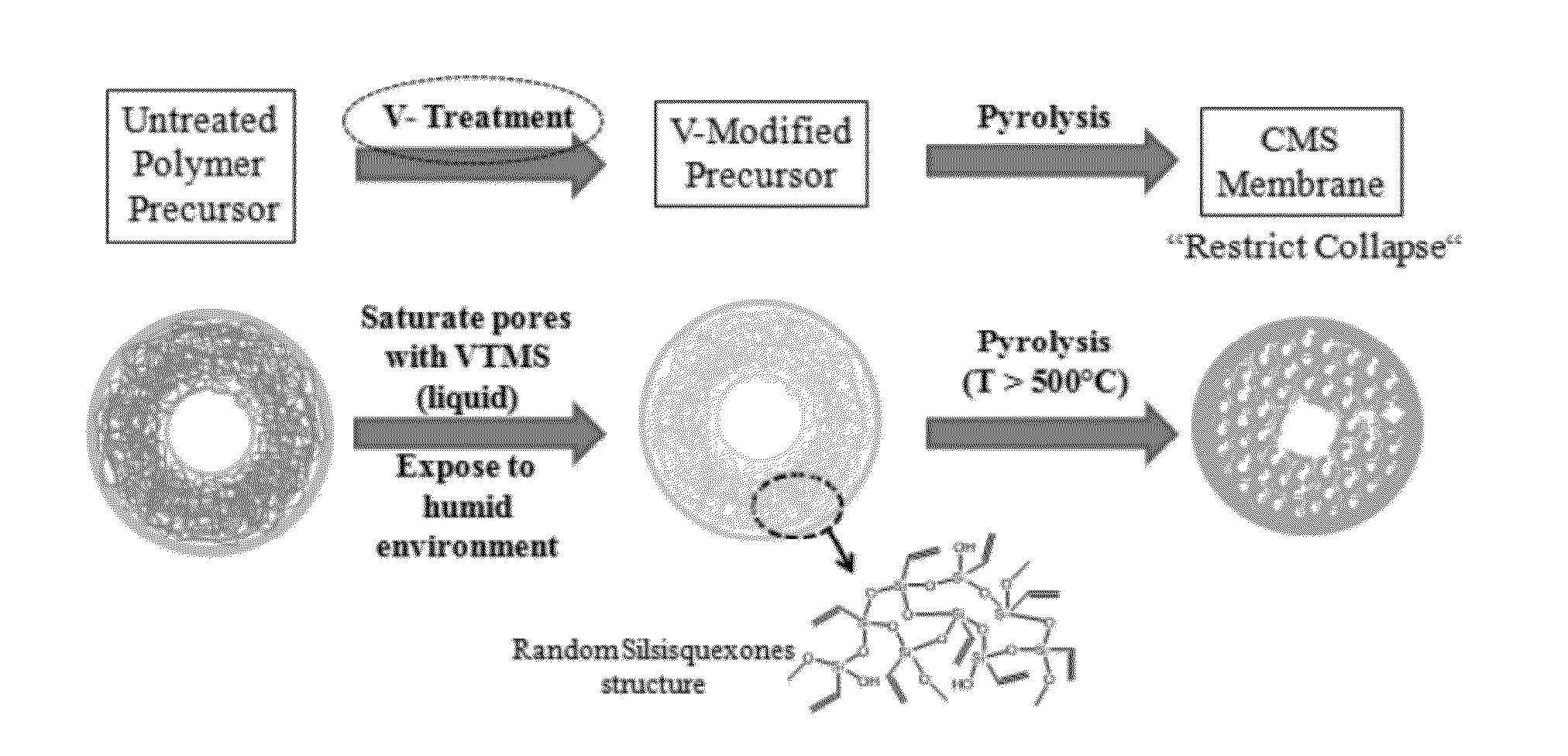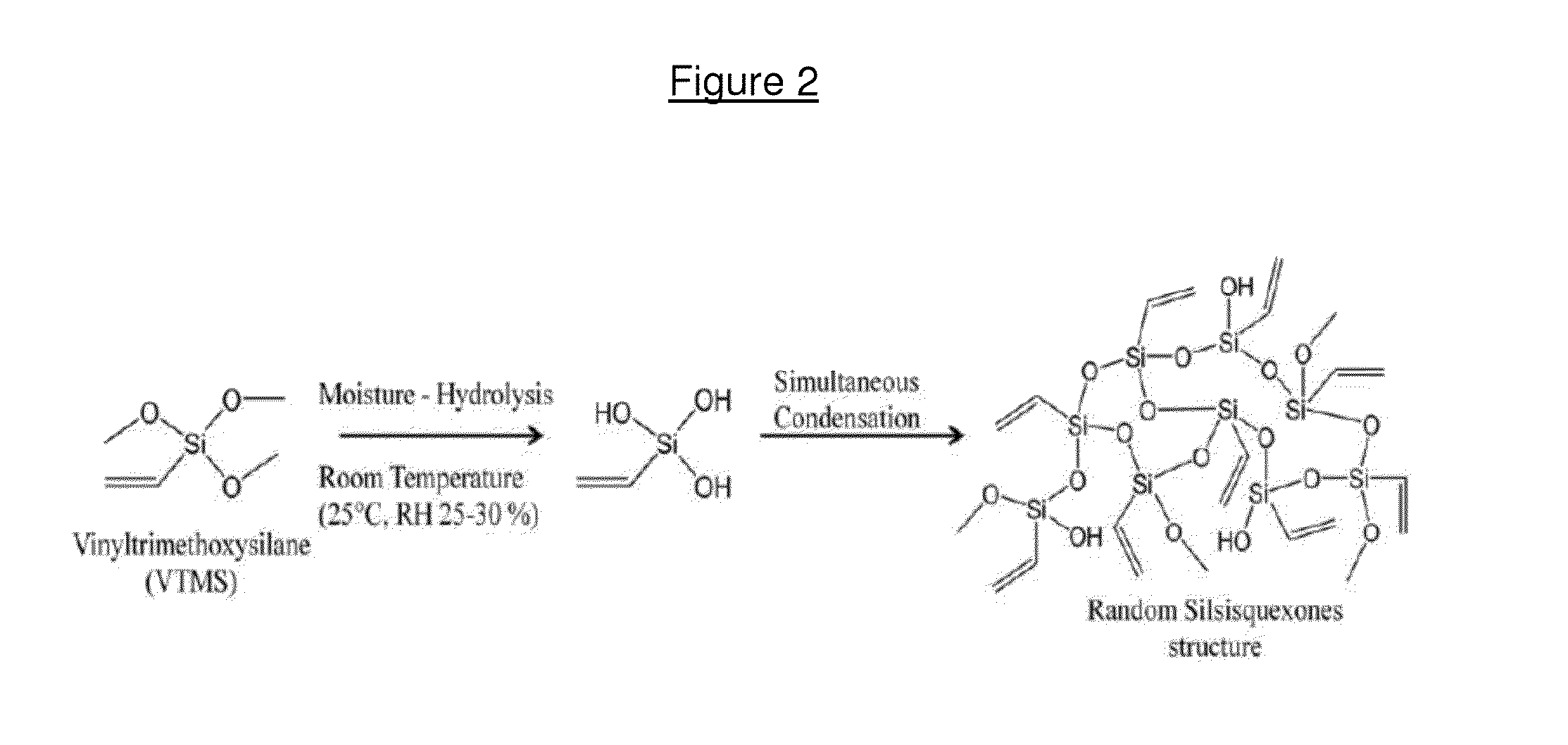Asymmetric Modified Carbon Molecular Sieve Hollow Fiber Membranes Having Improved Permeance
- Summary
- Abstract
- Description
- Claims
- Application Information
AI Technical Summary
Benefits of technology
Problems solved by technology
Method used
Image
Examples
example 1
[0048]Matrimid® 5218 precursor fibers were soaked in pure VTMS at room temperature for about twelve hours. The fibers were then removed and placed into a glove bag saturated with air of relative humidity at about 100%. After about forty-eight hours, the fibers were removed from the glove bag and dried under vacuum at 150° C. for about twelve hours. A portion of the treated Matrimid® 5218 precursor fibers were reserved for testing. The remainder of the treated Matrimid® 5218 precursor fibers were pyrolyzed under an atmosphere of ultra-high purity argon (˜99.9%) at a maximum pyrolysis temperature of about 650° C. The fibers were held at the maximum pyrolysis temperature for about two hours.
[0049]Both the treated Matrimid® 5218 precursor fibers, i.e. the pre-pyrolysis fibers, and the modified CMS hollow fibers, i.e. the post-pyrolysis fibers, were tested by 29Si solid state nuclear magnetic resonance (NMR). After treatment with VTMS, the Matrimid® 5218 precursor fibers exhibited peaks ...
example 2
[0050]Matrimid® 5218 precursor fibers were soaked in pure VTMS at room temperature for about twelve hours. The fibers were then removed and placed into a glove bag saturated with air of relative humidity at about 100%. After about forty-eight hours, the fibers were removed from the glove bag and dried under vacuum at 150° C. for about twelve hours.
[0051]The treated Matrimid® 5218 precursor fibers were tested by 13C solution nuclear magnetic resonance (NMR) and the results compared against the 13C solution nuclear magnetic resonance spectrum for untreated Matrimid® 5218 precursor fibers. The results are shown in FIG. 6. Notably, the 13C solution NMR spectrum of the treated Matrimid® 5218 precursor fibers has no substantial difference from the 13C solution NMR spectrum of the Matrimid® 5218 precursor fibers that were not contacted with the VTMS modifying agent. These results indicate that the modifying agent does not react with the Matrimid® 5218 precursor fiber, i.e. that the sol-gel...
example 3
[0079]A solution of hexane and VTMS was prepared. The VTMS made up 75 percent by weight (75 wt %) of the solution. Matrimid® 5218 precursor fibers were soaked in the solution for a time of about twelve hours. The fibers were then removed from the solution and placed in a glove bag containing air at a relative humidity of 100%. After about 48 hours, the fibers were removed and dried by heating under vacuum at 150° C. for about 12 hours. The treated precursor fibers were then placed on a stainless steel wire mesh and held in place by wrapping a length of wire around the mesh and fibers. The mesh support containing the fibers was then loaded to a pyrolysis setup, such as the type that is illustrated in FIG. 14. Pyrolysis was performed under an atmosphere of ultra high purity argon (99.9% pure) as follows:
1. 50° C. to 250° C. at a ramp rate of 13.3° C. / min
2. 250° C. to 635° C. at a ramp rate of 3.85° C. / min
3. 635° C. to 650° C. at a ramp rate of 0.25° C. / min
4. Soak for 2 hours at 650° C...
PUM
| Property | Measurement | Unit |
|---|---|---|
| Fraction | aaaaa | aaaaa |
| Concentration | aaaaa | aaaaa |
| Aliphatic | aaaaa | aaaaa |
Abstract
Description
Claims
Application Information
 Login to View More
Login to View More - R&D
- Intellectual Property
- Life Sciences
- Materials
- Tech Scout
- Unparalleled Data Quality
- Higher Quality Content
- 60% Fewer Hallucinations
Browse by: Latest US Patents, China's latest patents, Technical Efficacy Thesaurus, Application Domain, Technology Topic, Popular Technical Reports.
© 2025 PatSnap. All rights reserved.Legal|Privacy policy|Modern Slavery Act Transparency Statement|Sitemap|About US| Contact US: help@patsnap.com



